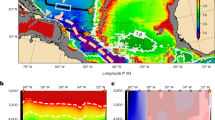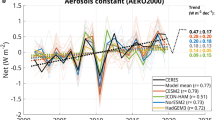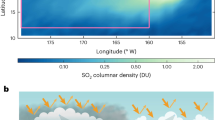Abstract
In stark contrast to the Arctic, there have been statistically significant positive trends in total Antarctic sea ice extent since 1979. However, the short and highly variable nature of observed Antarctic sea ice extent limits the ability to fully understand the historical context of these recent changes. To meet this challenge, we have created robust, observation-based reconstruction ensembles of seasonal Antarctic sea ice extent since 1905. Using these reconstructions, here we show that the observed period since 1979 is the only time all four seasons demonstrate significant increases in total Antarctic sea ice in the context of the twentieth century and that the observed increases are juxtaposed against statistically significant decreases throughout much of the early and middle twentieth century. These reconstructions provide reliable estimates of seasonally resolved total Antarctic sea ice extent and are skilful enough to better understand aspects of air–sea–ice interactions within the Antarctic climate system.
This is a preview of subscription content, access via your institution
Access options
Access Nature and 54 other Nature Portfolio journals
Get Nature+, our best-value online-access subscription
$29.99 / 30 days
cancel any time
Subscribe to this journal
Receive 12 print issues and online access
$209.00 per year
only $17.42 per issue
Buy this article
- Purchase on Springer Link
- Instant access to full article PDF
Prices may be subject to local taxes which are calculated during checkout





Similar content being viewed by others
Data availability
The reconstructions and the sea ice observations used to create them are all available on figshare59 at https://doi.org/10.6084/m9.figshare.c.5709767.v1. Soon after publication, the sea ice extent reconstructions will also be made available through the NSIDC.
Code availability
The reconstruction and all figures were generated using the NCAR Command Language. All code used to generate the figures in this paper is available in the Antarctic Sea Ice collection on figshare at https://doi.org/10.6084/m9.figshare.c.5709767.v1.
References
Hobbs, W. R. et al. A review of recent changes in Southern Ocean sea ice, their drivers and forcings. Glob. Planet. Change 143, 228–250 (2016).
Cavalieri, D. J. & Parkinson, C. L. Antarctic sea ice variability and trends, 1979–2006. J. Geophys. Res. https://doi.org/10.1029/2007JC004564 (2008).
Parkinson, C. L. & Cavalieri, D. J. Antarctic sea ice variability and trends, 1979–2010. Cryosphere 6, 871–880 (2012).
Parkinson, C. L. A 40-y record reveals gradual Antarctic sea ice increases followed by decreases at rates far exceeding the rates seen in the Arctic. Proc. Natl Acad. Sci. USA 116, 14414–14423 (2019).
Stroeve, J. & Notz, D. Changing state of Arctic sea ice across all seasons. Environ. Res. Lett. 13, 103001 (2018).
Turner, J., Hosking, J. S., Bracegirdle, T. J., Marshall, G. J. & Phillips, T. Recent changes in Antarctic sea ice. Phil. Trans. R. Soc. Math. Phys. Eng. Sci. 373, 20140163 (2015).
Holland, P. R. The seasonality of Antarctic sea ice trends. Geophys. Res. Lett. 41, 4230–4237 (2014).
Stammerjohn, S. et al. The influence of winds, sea-surface temperature and precipitation anomalies on Antarctic regional sea-ice conditions during IPY 2007. Deep Sea Res. 2 Top. Stud. Oceanogr. 58, 999–1018 (2011).
Stammerjohn, S. E., Martinson, D. G., Smith, R. C., Yuan, X. & Rind, D. Trends in Antarctic annual sea ice retreat and advance and their relation to El Niño–Southern Oscillation and Southern Annular Mode variability. J. Geophys. Res. https://doi.org/10.1029/2007JC004269 (2008).
Holland, P. R. & Kwok, R. Wind-driven trends in Antarctic sea-ice drift. Nat. Geosci. 5, 872–875 (2012).
Purich, A. & England, M. H. Tropical teleconnections to Antarctic sea ice during austral spring 2016 in coupled pacemaker experiments. Geophys. Res. Lett. https://doi.org/10.1029/2019GL082671 (2019).
Meehl, G. A., Arblaster, J. M., Bitz, C. M., Chung, C. T. Y. & Teng, H. Antarctic sea-ice expansion between 2000 and 2014 driven by tropical Pacific decadal climate variability. Nat. Geosci. 9, 590–595 (2016).
Jones, J. M. et al. Assessing recent trends in high-latitude southern hemisphere surface climate. Nat. Clim. Change 6, 917–926 (2016).
Turner, J., Bracegirdle, T. J., Phillips, T., Marshall, G. J. & Hosking, J. S. An initial assessment of Antarctic sea ice extent in the CMIP5 models. J. Clim. 26, 1473–1484 (2013).
Shu, Q. et al. Assessment of sea ice extent in CMIP6 with comparison to observations and CMIP5. Geophys. Res. Lett. https://doi.org/10.1029/2020GL087965 (2020).
Roach, L. A. et al. Antarctic sea ice area in CMIP6. Geophys. Res. Lett. https://doi.org/10.1029/2019GL086729 (2020).
Thomas, E. R. et al. Antarctic sea ice proxies from marine and ice core archives suitable for reconstructing sea ice over the past 2000 years. Geosciences 9, https://doi.org/10.3390/geosciences9120506 (2019).
Abram, N. J. et al. Ice core evidence for a 20th century decline of sea ice in the Bellingshausen Sea, Antarctica. J. Geophys. Res. https://doi.org/10.1029/2010JD014644 (2010).
Yang, J., Xiao, C., Liu, J., Li, S. & Qin, D. Variability of Antarctic sea ice extent over the past 200 years. Sci. Bull. https://doi.org/10.1016/j.scib.2021.07.028 (2021).
Dalaiden, Q., Goosse, H., Rezsohazy, J. & Thomas, E. R. Reconstructing atmospheric circulation and sea-ice extent in the West Antarctic over the past 200 years using data assimilation. Clim. Dyn. https://doi.org/10.1007/s00382-021-05879-6 (2021).
Raphael, M. N. & Hobbs, W. The influence of the large-scale atmospheric circulation on Antarctic sea ice during ice advance and retreat seasons. Geophys. Res. Lett. 41, 5037–5045 (2014).
Fogt, R. L. et al. Antarctic station-based seasonal pressure reconstructions since 1905. 1. Reconstruction evaluation: Antarctic pressure evaluation. J. Geophys. Res. Atmos. 121, 2814–2835 (2016).
Fogt, R. L. et al. A twentieth century perspective on summer Antarctic pressure change and variability and contributions from tropical SSTs and ozone depletion. Geophys. Res. Lett. 44, 9918–9927 (2017).
Jones, J. M. et al. Historical SAM variability. Part I: century-length seasonal reconstructions. J. Clim. 22, 5319–5345 (2009).
Fogt, R. L. et al. Seasonal Antarctic pressure variability during the twentieth century from spatially complete reconstructions and CAM5 simulations. Clim. Dyn. https://doi.org/10.1007/s00382-019-04674-8 (2019).
Turner, J. et al. Recent decrease of summer sea ice in the Weddell Sea, Antarctica. Geophys. Res. Lett. https://doi.org/10.1029/2020GL087127 (2020).
Stuecker, M. F., Bitz, C. M. & Armour, K. C. Conditions leading to the unprecedented low Antarctic sea ice extent during the 2016 austral spring season. Geophys. Res. Lett. 44, 9008–9019 (2017).
Bushuk, M. et al. Seasonal prediction and predictability of regional Antarctic sea ice. J. Clim. https://doi.org/10.1175/JCLI-D-20-0965.1 (2021).
Thomas, E. R. & Abram, N. J. Ice core reconstruction of sea ice change in the Amundsen–Ross Seas since 1702 A.D. Geophys. Res. Lett. 43, 5309–5317 (2016).
Murphy, E. J., Clarke, A., Symon, C. & Priddle, J. Temporal variation in Antarctic sea-ice: analysis of a long term fast-ice record from the South Orkney Islands. Deep Sea Res. 1 Oceanogr. Res. Pap. 42, 1045–1062 (1995).
Curran, M. A. J., van Ommen, T. D., Morgan, V. I., Phillips, K. L. & Palmer, A. S. Ice core evidence for Antarctic sea ice decline since the 1950s. Science 302, 1203–1206 (2003).
Purich, A. et al. Tropical Pacific SST drivers of recent Antarctic sea ice trends. J. Clim. 29, 8931–8948 (2016).
Raphael, M. N. et al. The Amundsen Sea Low: variability, change, and impact on Antarctic climate. Bull. Am. Meteorol. Soc. 97, 111–121 (2016).
Hosking, J. S., Orr, A., Marshall, G. J., Turner, J. & Phillips, T. The influence of the Amundsen–Bellingshausen Seas low on the climate of west Antarctica and its representation in coupled climate model simulations. J. Clim. 26, 6633–6648 (2013).
Turner, J. et al. The SCAR READER project: toward a high-quality database of mean Antarctic meteorological observations. J. Clim. 17, 2890–2898 (2004).
Turner, J. et al. Antarctic climate change during the last 50 years. Int. J. Climatol. 25, 279–294 (2005).
Turner, J. et al. Antarctic temperature variability and change from station data. Int. J. Climatol. https://doi.org/10.1002/joc.6378 (2019).
Fan, T., Deser, C. & Schneider, D. P. Recent Antarctic sea ice trends in the context of Southern Ocean surface climate variations since 1950. Geophys. Res. Lett. 41, 2419–2426 (2014).
Zhang, L., Delworth, T. L., Cooke, W. & Yang, X. Natural variability of southern ocean convection as a driver of observed climate trends. Nat. Clim. Change 9, 59–65 (2019).
Fogt, R. L. & Connolly, C. J. Extratropical southern hemisphere synchronous pressure variability in the early twentieth century. J. Clim. 34, 5795–5811 (2021).
Fogt, R. L. et al. Historical SAM variability. Part II: twentieth-century variability and trends from reconstructions, observations, and the IPCC AR4 models. J. Clim. 22, 5346–5365 (2009).
Schneider, D. P. & Fogt, R. L. Artifacts in century-length atmospheric and coupled reanalyses over Antarctica due to historical data availability. Geophys. Res. Lett. 45, 964–973 (2018).
Meier, W., Fetterer, F., Windnagel, A. & Stewart, S. NOAA/NSIDC Climate Data Record of Passive Microwave Sea Ice Concentration Version 4 (NOAA/NSIDC, 2021); https://doi.org/10.7265/EFMZ-2T65
World Monthly Surface Station Climatology (UCAR, 1981); https://rda.ucar.edu/datasets/ds570.0/
Zazulie, N., Rusticucci, M. & Solomon, S. Changes in climate at high southern latitudes: a unique daily record at Orcadas spanning 1903–2008. J. Clim. 23, 189–196 (2010).
Global Surface Summary of the Day (National Centers for Environmental Information, 2021); https://www.ncei.noaa.gov/access/metadata/landing-page/bin/iso?id=gov.noaa.ncdc:C00516
Feistel, R., Hagen, E. & Grant, K. Climatic changes in the subtropical Southeast Atlantic: the St. Helena Island Climate Index (1893–1999). Prog. Oceanogr. 59, 321–337 (2003).
Henley, B. J. et al. A tripole index for the Interdecadal Pacific Oscillation. Clim. Dyn. 45, 3077–3090 (2015).
Huang, B. et al. Extended Reconstructed Sea Surface Temperature Version 4 (ERSST.v4). Part I: upgrades and intercomparisons. J. Clim. 28, 911–930 (2015).
Mantua, N. J. & Hare, S. R. The Pacific decadal oscillation. J. Oceanogr. 58, 35–44 (2002).
Enfield, D. B., Mestas-Nuñez, A. M. & Trimble, P. J. The Atlantic Multidecadal Oscillation and its relation to rainfall and river flows in the continental U.S. Geophys. Res. Lett. 28, 2077–2080 (2001).
Fogt, R. L. & Marshall, G. J. The Southern Annular Mode: variability, trends, and climate impacts across the southern hemisphere. WIREs Clim. Change https://doi.org/10.1002/wcc.652 (2020).
Marshall, G. J. Trends in the southern annular mode from observations and reanalyses. J. Clim. 16, 4134–4143 (2003).
Cavalieri, D. J., Gloersen, P. & Campbell, W. J. Determination of sea ice parameters with the NIMBUS 7 SMMR. J. Geophys. Res. Atmos. 89, 5355–5369 (1984).
Comiso, J. C. Characteristics of Arctic winter sea ice from satellite multispectral microwave observations. J. Geophys. Res. 91, https://doi.org/10.1029/JC091iC01p00975 (1986).
Handcock, M. S. & Raphael, M. N. Modeling the annual cycle of daily Antarctic sea ice extent. Cryosphere 14, 2159–2172 (2020).
Clark, L. & Fogt, R. Southern hemisphere pressure relationships during the 20th century—implications for climate reconstructions and model evaluation. Geosciences 9, https://doi.org/10.3390/geosciences9100413 (2019).
Cook, E. R., Meko, D. M., Stahle, D. W. & Cleaveland, M. K. Drought reconstructions for the continental United States. J. Clim. 12, 1145–1162 (1999).
Fogt, R. Antarctic sea ice reconstructions. Figshare https://doi.org/10.6084/M9.FIGSHARE.C.5709767.V1 (2021).
Acknowledgements
All authors acknowledge support from the National Science Foundation Office of Polar Programs. R.L.F. and A.M.S. were supported by grant no. OPP-1744998, and M.N.R. and M.S.H. were supported by grant no. OPP-1745089.
Author information
Authors and Affiliations
Contributions
R.L.F., M.N.R. and M.S.H. conceived the study. R.L.F. and A.M.S. performed the reconstructions. R.L.F. led the writing of the manuscript and produced all the figures in the paper. All authors analysed the results and assisted in writing and editing the manuscript.
Corresponding author
Ethics declarations
Competing interests
The authors declare no competing interests.
Peer review information
Nature Climate Change thanks Sharon Stammerjohn, Elizabeth Thomas and the other, anonymous, reviewer(s) for their contribution to the peer review of this work.
Additional information
Publisher’s note Springer Nature remains neutral with regard to jurisdictional claims in published maps and institutional affiliations.
Extended data
Extended Data Fig. 1 Map of predictor stations, additional climate index data layers, and sea ice sectors.
Sea ice sectors are defined as in Raphael and Hobbs (2014). Station data are primarily from the University Corporation for Atmospheric Research research data archive dataset ds570.0 (https://rda.ucar.edu/datasets/ds570.0/#!description). See Methods for a more detailed description of data sources and sea ice sectors.
Extended Data Fig. 2 Boxplots of reconstruction performance.
Boxplots for reconstruction performance across all ensembles are in blue, and the best fit reconstruction for each sector, including total are in red. The vertical lines extend to the minimum and maximum for each skill metric, and the boxes extend to the upper and lower quartiles. The median for each distribution is given with the horizontal line in the middle of each boxplot.
Extended Data Fig. 3 Changes in year-to-year seasonal sea ice extent.
Seasonal probability density functions (PDF, in %) for differences (following year minus preceding year) in consecutive one year values in observed Antarctic total sea ice extent (black, plotted as a bar chart) and in all Antarctic total sea ice extent ensemble members from 1979–2020 (red) and 1905–2020 (blue). The dashed vertical lines indicate the minimum and maximum differences in observations, with the years corresponding to these record differences given in the upper corners within each panel.
Rights and permissions
About this article
Cite this article
Fogt, R.L., Sleinkofer, A.M., Raphael, M.N. et al. A regime shift in seasonal total Antarctic sea ice extent in the twentieth century. Nat. Clim. Chang. 12, 54–62 (2022). https://doi.org/10.1038/s41558-021-01254-9
Received:
Accepted:
Published:
Issue Date:
DOI: https://doi.org/10.1038/s41558-021-01254-9
This article is cited by
-
Record low Antarctic sea ice coverage indicates a new sea ice state
Communications Earth & Environment (2023)
-
A new record minimum for Antarctic sea ice
Nature Reviews Earth & Environment (2022)
-
The relative role of the subsurface Southern Ocean in driving negative Antarctic Sea ice extent anomalies in 2016–2021
Communications Earth & Environment (2022)



